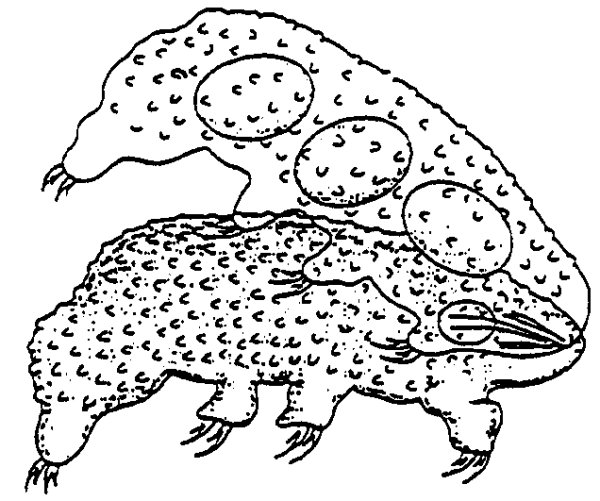that the Onychophora have a fossil record
extending right back to the Cambrian explosion. Modem velvet worms live
in moist, terrestrial habitats, usually in wet leaves or rotting wood. Most
of the eighty or so species are one to three inches in length and have an
elongated body with fourteen to forty-three pairs of stumpy legs (called
lobopods) behind a head bearing three pairs of appendages (antennae, jaws,
and slime papillae, used by these carnivores to shoot a sticky substance
at prey). The entire animal looks vaguely like a caterpillar, although onychophorans
have no close genealogical relationship with these larvae of moths and butterflies.
Cambrian onychophorans have been proposed for eighty years, since the discovery
of Aysheaia, a soft-bodied fossil from the famous Burgess Shale in
British Columbia. But Aysheaia had remained in limbo, with many paleontologists
doubting its proper inclusion among the velvet worms, until the discovery
of at least four more Cambrian genera during the past ten years, including
a reinterpretation of Hallucigenia, once the most enigmatic of all
Burgess Shale creatures, as an onychophoran originally misconstrued as upside
down. These exciting finds show that velvet worms are only minor in current
membership and restricted ecological spread. The Onychophora began as a
diverse and important group of Cambrian marine invertebrates.
Walossek and Miller have now discovered Cambrian fossils of tardigrades
and pentastomes as well, so we can now affirm that all three phyla go
right back to the initial diversification of multicellular animal life
in the Cambrian explosion. Until these exciting publications, neither
tardigrades nor pentastomes had a recognized fossil record at all--not
a single specimen from any time. So these new discoveries from
A female tardigrade, or water bear, molts her egg-filled cuticle.
Nancy J. Haver, after Morgan, 1982. From invertebrates, Brusca and Brusca,
1990
the dawn of phyla allow both groups to leapfrog from the present right
back to the beginning.
Living tardigrades are tiny creatures, usually only one-tenth to one-half
millimeter in length (hardly visible since one inch contains 25.4 millimeters),
although the "giant" of the phylum reaches 1.7 millimeters. Most
of the 400 species live in water films on mosses, lichens, flowering plants,
soil, or forest litter, although some inhabit freshwater or marine environments
on the sediment surfaces of ponds or ocean basins. They look like tiny eight-legged
bears, and they move with a lumbering gait--hence their common designation
of "water bear," although the etymology of their technical name
also invokes form and motion, for tardigrade means slow-stepper.
Tardigrades have attained a certain notoriety in popular science writing
for a suite of unusual features--not to mention their charmingly humorous
appearance. Some species indulge in an odd form of reproduction by indirect
fertilization. Males penetrate the female's cuticle and deposit sperm beneath. The female
then sheds her cuticle (for tardigrades, like insects, grow by molting
an external covering and secreting a new and larger version), and lays eggs
into this discarded outer shell, already well supplied with previously deposited
sperm.
But tardigrades are most famous for their astonishing capacity to shut off
metabolism and endure long periods of dormancy--a condition known as
cryptobiosis and defined as a state of dormancy so extreme that no external
sign of metabolic activity can be detected at all.
If their habitat dries up (and life in terrestrial water films can be
precarious), tardigrades can pull in their legs and secrete a cuticle
about their withered body. In this so-called tun stage, tardigrades can
survive extreme insults perpetrated by nature or invented by human experimenters--such
as immersion in absolute alcohol, ether, or liquid helium and exposure
to temperatures ranging from 149º C (well above the boiling point
of water) to -272º C (not so far from absolute zero)! When water
becomes available again, the animal swells up and returns to activity
within a few hours. No one knows how long a tardigrade tun might survive.
The Bruscas' text recounts one tale (likely apocryphal) of living tardigrades
emerging from a museum specimen of moss that had been moistened after
120 years of dry shelf life. Unsurprisingly, tardigrades have
10 NATURAL HISTORY 1/95
|
